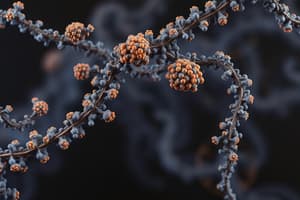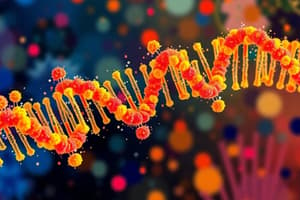Podcast
Questions and Answers
What is the primary function of TERC in relation to telomerase?
What is the primary function of TERC in relation to telomerase?
- It serves as a guide for telomerase binding. (correct)
- It acts as a primer for DNA replication.
- It helps in the degradation of mRNA.
- It silences target genes.
HOTAIR is an ncRNA that enhances gene expression by modifying histones.
HOTAIR is an ncRNA that enhances gene expression by modifying histones.
False (B)
What does telomerase add to the end of the chromosome, and what is its purpose?
What does telomerase add to the end of the chromosome, and what is its purpose?
Excess DNA, to create room for future primer.
The ncRNA known as ______ regulates transcription by forming a scaffold for protein complexes.
The ncRNA known as ______ regulates transcription by forming a scaffold for protein complexes.
Match the following terms with their definitions:
Match the following terms with their definitions:
What percentage of transcription in a typical human cell is associated with making ncRNAs?
What percentage of transcription in a typical human cell is associated with making ncRNAs?
Non-coding RNAs can only bind to DNA.
Non-coding RNAs can only bind to DNA.
What is a ribozyme?
What is a ribozyme?
NcRNAs can affect processes of __________, transcription, and translation.
NcRNAs can affect processes of __________, transcription, and translation.
Match the following functionalities of ncRNAs with their respective roles:
Match the following functionalities of ncRNAs with their respective roles:
Which of the following is NOT a function of non-coding RNAs?
Which of the following is NOT a function of non-coding RNAs?
Only a small portion of ncRNAs have roles in human diseases.
Only a small portion of ncRNAs have roles in human diseases.
What is the primary difference between coding and non-coding RNAs?
What is the primary difference between coding and non-coding RNAs?
What is the repeat sequence found in human telomeres?
What is the repeat sequence found in human telomeres?
As cells divide, telomeres become longer.
As cells divide, telomeres become longer.
What enzyme is responsible for adding repeating sequences to telomeres?
What enzyme is responsible for adding repeating sequences to telomeres?
The ends of the chromosomes cannot be fully replicated by __________.
The ends of the chromosomes cannot be fully replicated by __________.
What happens to a cell when its telomeres become too short?
What happens to a cell when its telomeres become too short?
What is the function of telomeres?
What is the function of telomeres?
Telomere lengthening occurs in _______ steps.
Telomere lengthening occurs in _______ steps.
What is one primary function of the Signal Recognition Particle (SRP)?
What is one primary function of the Signal Recognition Particle (SRP)?
SRP is composed solely of protein.
SRP is composed solely of protein.
What must bind GTP for SRP to bind to its receptor in the ER membrane?
What must bind GTP for SRP to bind to its receptor in the ER membrane?
The SRP changes a protein's function to open a __________ for the polypeptide.
The SRP changes a protein's function to open a __________ for the polypeptide.
What is the result of GTP hydrolysis in the SRP and SRP receptor complex?
What is the result of GTP hydrolysis in the SRP and SRP receptor complex?
During translation, SRP pauses the process upon binding to an ER signal __________.
During translation, SRP pauses the process upon binding to an ER signal __________.
What is the relationship between SRP and non-coding RNA (ncRNA)?
What is the relationship between SRP and non-coding RNA (ncRNA)?
Match the following components with their roles in the SRP pathway:
Match the following components with their roles in the SRP pathway:
What is the role of the Cas9 protein in the interference phase?
What is the role of the Cas9 protein in the interference phase?
NcRNAs have no impact on human diseases.
NcRNAs have no impact on human diseases.
Name one type of cancer where abnormal expression levels of certain miRNAs have been found.
Name one type of cancer where abnormal expression levels of certain miRNAs have been found.
HOTAIR behaves as an ______ when overexpressed.
HOTAIR behaves as an ______ when overexpressed.
Match the following roles of ncRNAs with their applications:
Match the following roles of ncRNAs with their applications:
What is the primary function of the CRISPR-Cas system in bacteria?
What is the primary function of the CRISPR-Cas system in bacteria?
The type II CRISPR-Cas system contains multiple types of CRISPR-associated genes.
The type II CRISPR-Cas system contains multiple types of CRISPR-associated genes.
What proteins form a complex to recognize and cleave foreign bacteriophage DNA during the adaptation phase?
What proteins form a complex to recognize and cleave foreign bacteriophage DNA during the adaptation phase?
In the interference phase, the tracrRNA-crRNA-Cas9 complex binds to the __________ protein.
In the interference phase, the tracrRNA-crRNA-Cas9 complex binds to the __________ protein.
Match the following stages of the CRISPR-Cas system with their descriptions:
Match the following stages of the CRISPR-Cas system with their descriptions:
Which non-coding RNA is involved in the CRISPR-Cas system's defense mechanism?
Which non-coding RNA is involved in the CRISPR-Cas system's defense mechanism?
The expression phase occurs after the bacterial cell has been exposed to a bacteriophage for the first time.
The expression phase occurs after the bacterial cell has been exposed to a bacteriophage for the first time.
What happens to the pre-crRNA during the expression phase?
What happens to the pre-crRNA during the expression phase?
Flashcards
Non-coding RNA (ncRNA)
Non-coding RNA (ncRNA)
RNA molecules that do not code for proteins.
mRNA
mRNA
RNA that carries genetic information for protein synthesis from DNA to ribosomes.
ncRNA binding
ncRNA binding
ncRNAs bind to other molecules through complementary base pairing & other methods, affecting processes such as replication, transcription, & translation.
Ribozyme
Ribozyme
Signup and view all the flashcards
Gene silencing
Gene silencing
Signup and view all the flashcards
Base Pairing
Base Pairing
Signup and view all the flashcards
DNA cutting
DNA cutting
Signup and view all the flashcards
ncRNA function
ncRNA function
Signup and view all the flashcards
Telomerase action
Telomerase action
Signup and view all the flashcards
HOTAIR function
HOTAIR function
Signup and view all the flashcards
dsRNA potency
dsRNA potency
Signup and view all the flashcards
MicroRNA (miRNA) vs. siRNA
MicroRNA (miRNA) vs. siRNA
Signup and view all the flashcards
Chromosome Replication Primers
Chromosome Replication Primers
Signup and view all the flashcards
Telomeres
Telomeres
Signup and view all the flashcards
Telomere shortening
Telomere shortening
Signup and view all the flashcards
Telomerase
Telomerase
Signup and view all the flashcards
DNA polymerase
DNA polymerase
Signup and view all the flashcards
Primer
Primer
Signup and view all the flashcards
Eukaryotic chromosome replication
Eukaryotic chromosome replication
Signup and view all the flashcards
ncRNA in telomere replication
ncRNA in telomere replication
Signup and view all the flashcards
3 Steps of telomere lengthening
3 Steps of telomere lengthening
Signup and view all the flashcards
SRP function in protein sorting
SRP function in protein sorting
Signup and view all the flashcards
SRP receptor
SRP receptor
Signup and view all the flashcards
ER channel
ER channel
Signup and view all the flashcards
GTP hydrolysis role in SRP
GTP hydrolysis role in SRP
Signup and view all the flashcards
CRISPR-Cas system
CRISPR-Cas system
Signup and view all the flashcards
CRISPR sequences
CRISPR sequences
Signup and view all the flashcards
Cas proteins
Cas proteins
Signup and view all the flashcards
CRISPR spacers
CRISPR spacers
Signup and view all the flashcards
ncRNA roles in cancer
ncRNA roles in cancer
Signup and view all the flashcards
ncRNA roles in plant health
ncRNA roles in plant health
Signup and view all the flashcards
Adaptation Phase
Adaptation Phase
Signup and view all the flashcards
Expression Phase
Expression Phase
Signup and view all the flashcards
Interference Phase
Interference Phase
Signup and view all the flashcards
tracrRNA
tracrRNA
Signup and view all the flashcards
Cas9
Cas9
Signup and view all the flashcards
Spacer
Spacer
Signup and view all the flashcards
Study Notes
CRISPR-Cas System
- Chinese scientist He Jiankui claimed to use CRISPR to genetically edit babies.
- He offered no evidence or data to support his claims.
- This act could open the door to "designer babies."
RNA Interference (RNAi)
- Double-stranded RNA is more potent at inhibiting mRNA than antisense RNA.
- The phenomenon was termed RNA interference.
- microRNAs (miRNAs): transcribed from endogenous eukaryotic genes and regulate gene expression. miRNAs are partially complementary to their mRNA targets.
- Small interfering RNAs (siRNAs): come from exogenous sources, and are usually perfectly complementary to their target mRNA. They play a role in preventing viral infections.
Non-coding RNAs (ncRNAs) and Gene Regulation
- ncRNAs bind to other molecules and macromolecules.
- ncRNAs have several common functions:
- Scaffold: bind to multiple components, act as scaffold for formation of a complex.
- Guide: guide one molecule to a specific location in the cell.
- Alteration of protein function or stability: bind to ncRNA to affect protein function/stability.
- Ribozyme: RNA molecule with catalytic function, for example peptidyltransferase activity of ribosome.
- Blocker: prevents or blocks a cellular process (binding to ribosomes inhibiting translation).
- Decoy: recognizes other ncRNAs and sequesters them, preventing them from working.
ncRNAs and Human Disease
- Abnormal expression levels of miRNAs have been found in nearly all forms of human cancer.
- Some miRNAs are tumor suppressors, some are oncogenes.
- HOTAIR is expressed in several cancers, behaving as an oncogene when overexpressed.
- Various ncRNAs are associated with neurological disorders (Alzheimer's disease) and cardiovascular diseases (arrhythmias).
ncRNAs in Plant Health
- Abnormalities in ncRNAs play essential roles in plant health.
- Their study is important for agriculture.
- Examples of ncRNAs involved in plant health include miRNA-156, COOLAIR, and IPS1.
Telomeres and DNA Replication
- The ends of linear eukaryotic chromosomes have telomeres composed of repeat sequences (e.g. 5' - GGGTTA-3' in humans)
- Telomeres protect the ends of chromosomes from entanglement and breakage.
- Telomeres shorten with each cell division; when they are too short, the cell can no longer successfully divide, leading to programmed cell death.
- Some cells express telomerase, an enzyme that adds repeating sequence and extends the telomeres.
- Telomeres cannot be fully replicated by DNA polymerase due to the 5' overhang of DNA.
- RNA primers are required for DNA polymerase to begin replication; primers are removed.
- Telomerase is the solution for synthesizing the full length of the top strand, which counteracts the problem of limited DNA replication at the end of DNA strands.
- Telomere length is regulated through TERC, an ncRNA that facilitates the binding of telomerase.
HOTAIR
- HOTAIR is an ncRNA in humans and other mammals
- It regulates transcription by forming a scaffold that binds two protein complexes and guides them to particular genes.
- The protein complexes covalently modify histones, leading to the silencing of target genes.
Signal Recognition Particle (SRP)
- SRP is composed of protein and ncRNA.
- It chaperones the ribosome to the ER.
- As a polypeptide is being made, SRP binds to the ER signal sequence, causing translation to pause.
- SRP binds to an SRP receptor in the ER membrane.
- GTP molecules bound to SRP and the SRP receptor are hydrolyzed, thereby releasing SRP.
- Translation resumes, and the polypeptide is threaded through a channel into the ER lumen.
CRISPR-Cas System (in detail)
- Some bacteria and archaea have a system called the CRISPR-Cas system that defends against bacteriophages (and transposons).
- The type II CRISPR-Cas system was described.
- The system involves three main components:
- Crispr genes (with repeats and spacers)
- TracrRNA (a noncoding RNA)
- Cas genes (encoding associated proteins, e.g., Cas9).
- Defense occurs in three phases:
- Adaptation: after bacterial exposure to a bacteriophage. Cas1 and Cas2 proteins cleave the bacteriophage DNA, and a piece of that DNA is added to the Crispr gene.
- Expression: tracrRNA bonds to complementary sequences of pre-crRNA; pre-crRNA is then cleaved into small crRNA molecules; each tracrRNA-crRNA complex binds to the Cas9 proteins.
- Interference: the tracrRNA-crRNA- Cas9 complex binds to bacteriophage DNA due to complementary base pairing. The Cas9 protein cleaves the bacteriophage DNA, thereby inactivating it.
Studying That Suits You
Use AI to generate personalized quizzes and flashcards to suit your learning preferences.
Related Documents
Description
This quiz explores the functions and characteristics of non-coding RNAs (ncRNAs) and telomerase, including their roles in gene expression and chromosome maintenance. Test your knowledge on the differences between coding and non-coding RNAs, the significance of telomerase, and how ncRNAs regulate various cellular processes.




